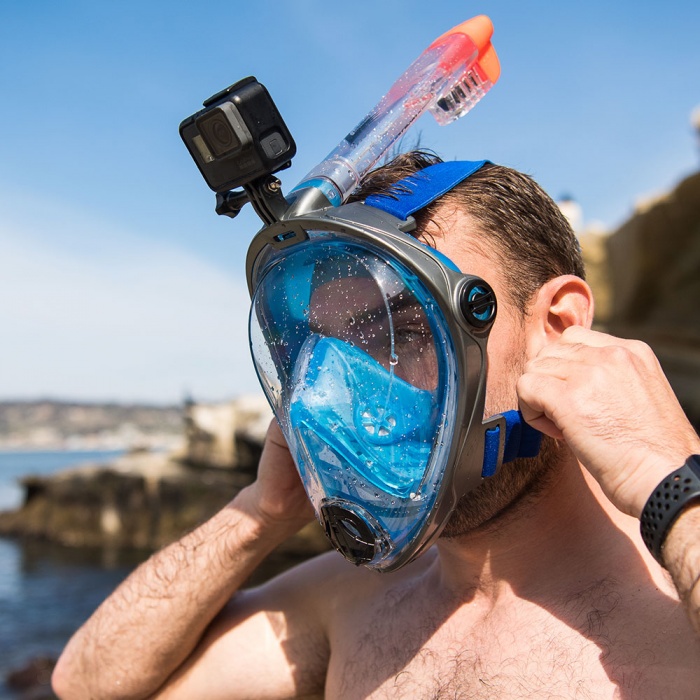There’s nothing like exploring the undersea world, which is why snorkeling is so popular worldwide.
Some people like to float face-down on the water’s surface and watch the marine life and surroundings without disturbing it. However, many people enjoy diving and swimming with fishes to experience the aquatic world.
No matter how they explore the sea, they will need equipment, but a snorkel is usually all they need.
How do snorkels work?
Nowadays, premium snorkels are lightweight and functional, making the overall experience easier and more enjoyable. They’re usually easy to put on and utilize.
An anti-leak seal over the snorkel prevents water from entering the breathing tube above surface level (which could happen quickly if someone splashes or a large wave breaks). For underwater activities, a device prevents water from entering. Shallow breathing is usually safe because the masks’ purge valves remove water from the tube with a deep breath.
Naturally, this depends on the snorkel. Wet, semi-dry, and dry are available at various prices. The aperture, tube, mask clasp, air reservoir, and mouthpiece are all included. However, semi-dry ones have splash guards, purge valves, and flex tubes. In addition, dry ones have float valves. Each piece affects the snorkel’s function, thus choosing the appropriate one is crucial. A user must also make sure their snorkel is well fitted and comfortable to perform smoothly, and it’s preferable to buy a good one.
What are snorkel masks?
While different from the detached kind mentioned above, Snorkel masks have a similar purpose and can be more beneficial to some individuals. They’re often integrated into a swimming or diving mask, which makes things much more straightforward for many users. A full-face mask allows users to breathe through the mouth and nose, as the tube is connected to the top of the mask rather than to the individual’s mouth. Like standard snorkels, they also have anti-leak seals and valves to prevent water from getting in.
With these, it’s essential to come back up to the surface frequently to replace the dead air inside with fresh oxygen before going back down.

Which type is best?
When choosing a snorkel, many people wonder which is “best”—but there is rarely a single answer. Instead, a few factors can assist a person choose the best one.
A simple snorkel has swimming goggles and a tube for the easiest experience. Surface snorkeling usually requires a mask. The main reason is because they need valves to close the mask’s air entrance underwater. Without them, water would flood in, but people must frequently breathe since the mask runs out of clean oxygen.
Depending on the model used, a detached snorkel can be good for a large number of underwater activities, such as:
- Spearfishing
- Finswimming
- Underwater hockey
- Underwater rugby
A scuba diving mask could be worn to snorkel. Most diving masks have lenses and a rubber skirt that closes against the face to keep water out (attached to the breathing tube). Diving masks come in several forms and styles, making it easier to pick one that suits you.
What other equipment is needed for snorkeling?
In most cases, a person will find that they don’t need anything other than their snorkel to explore the beautiful world beneath the surface – although there are other things that can be used. In certain situations, some pieces of equipment can actually be necessary. Here are a few examples of things that an individual might want/need to have:
Swim Fins
Essentially anyone who’s hoping to swim or partake in underwater activities should consider getting swim fins. Also called flippers, they can often help wearers swim much more efficiently since human feet are naturally too small (as well as not the right shape) to provide much thrust when moving underwater.
Scuba fins are essential for you to have a better diving experience, and you might find it challenging to find the right pair of fins. Check out our article Best Scuba Fins for Beginners and find out our top 5 picks.
Wetsuit
Wetsuits are commonly used by individuals who plan to participate in water sports and other aquatic-based activities. There are quite a few reasons why they can benefit those who plan to travel below the surface. Often, they can provide thermal insulation, buoyancy, and protection from ultraviolet exposure and abrasion, as well as more minor stings from marine organisms.
Weight belt
While snorkelers use a few weighting systems, weight belts tend to be the most common. Often, they’re made of durable and tough nylon webbing and have a quick-release buckle in case of emergency. Rectangular lead blocks with a plastic cover are some of the most popular on the market. The amount of them needed can generally vary based on the buoyancy of the wetsuit and the requirements of the wearer.
